24-hour Dietary Recall
Salt Sources Study
Att 11A_24 Hour Dietary Recall Interview_0108014
24-Hour Dietary Recall Interview
OMB: 0920-0982
24-HOUR DIETARY RECALL INTERVIEW
- INTRODUCTION SCRIPT, SCREEN SHOTS, AND INTERVIEW GUIDE
Average Interview Length: 30 minutes
Public reporting burden of this collection of information is estimated to average 30 minutes per response, including the time for reviewing instructions, searching existing data sources, gathering and maintaining the data needed, and completing and reviewing the collection of information. An agency may not conduct or sponsor, and a person is not required to respond to, a collection of information unless it displays a currently valid OMB control number. Send comments regarding this burden estimate or any other aspect of this collection of information, including suggestions for reducing this burden to CDC/ATSDR Reports Clearance Officer, 1600 Clifton Road, NE, M/S D74, Atlanta, GA 30333, ATTN: PRA 0920-0982.
APPENDIX I: INTRODUCTION SCRIPT
“Hi (insert participant’s name). My name is (insert your name). I’m with the Salt Sources Study. How are things going today?” (Pause, wait for their response, spend a moment to establish rapport, and proceed)
“Today we will collect information about what you ate and drank yesterday. I’ll also be asking you some questions about the duplicate salt samples you collected. Remember there are no right or wrong answers for these questions and whatever you ate is okay.”
“Before we start, do you have the Food Amounts Booklet? We’ll use that to help estimate how much you ate.”
Wait for them to respond and get the FAB if they don’t have it with them. If they do not have the FAB the interview must be rescheduled. Say the following:
“I’m sorry, but we need this booklet in order to conduct the interview. The study coordinator will mail you a new food amount booklet and will contact you to reschedule this interview.”
“Do you have the Food Record Form you completed with you? You may find this useful in recalling what you ate and drank yesterday.
Wait for them to respond and get the form if they don’t have it with them. If they didn’t complete the form or can’t find it, tell them that is OK and proceed.
“Did you remember to collect samples of salt added to food at the table yesterday?”
If they forgot to collect samples (used salt at table but forgot to collect duplicate samples) the interview must be rescheduled. Say the following:
“I’m sorry, but we can’t conduct this interview without the samples. The study coordinator will contact you to reschedule this interview.”
“Did you remember to collect samples of any salt added in home food preparation yesterday?”
If they forgot to collect samples (used salt in home food preparation but forgot to collect duplicate samples) the interview must be rescheduled. Say the following:
“I’m sorry, but we can’t conduct this interview without the samples. The study coordinator will contact you to reschedule this interview.”
“OK. Are you ready? Good. Let’s begin.”
APPENDIX II: QUICK LIST COLLECTION AND REVIEW WINDOW

APPENDIX III: MEAL INFORMATION WINDOW
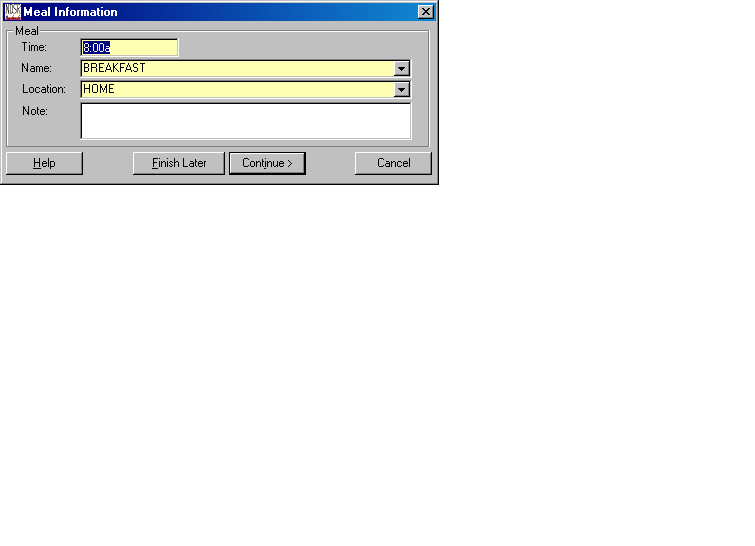
APPENDIX IV: FOOD ADDITIONS WINDOW
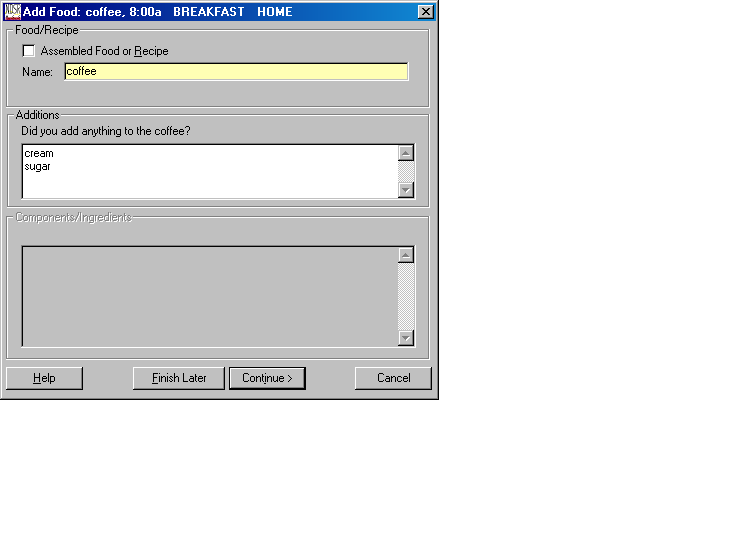
APPENDIX V: FOOD SEARCH WINDOW
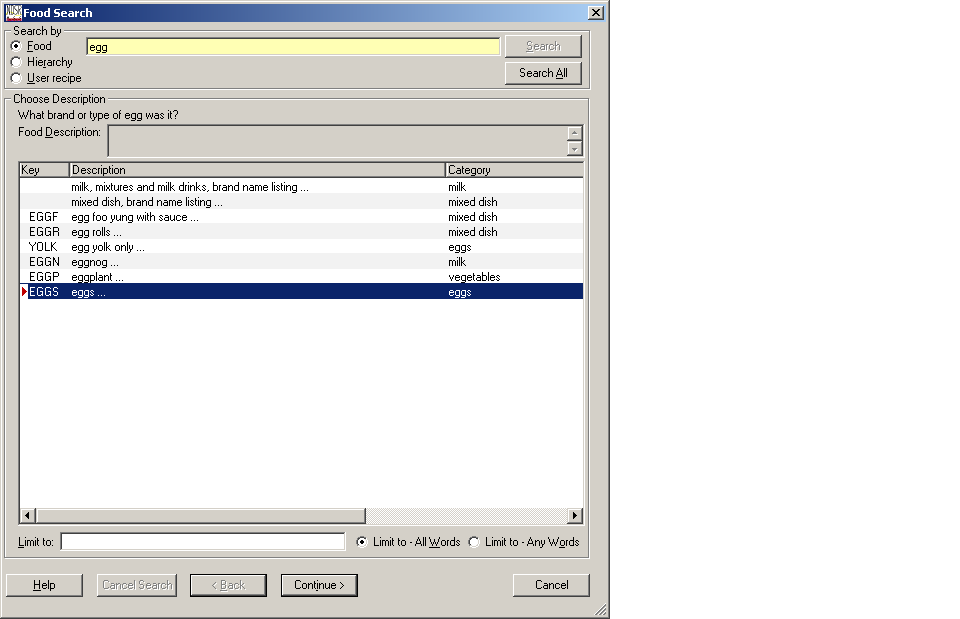
APPENDIX VI: FOOD DETAIL WINDOW
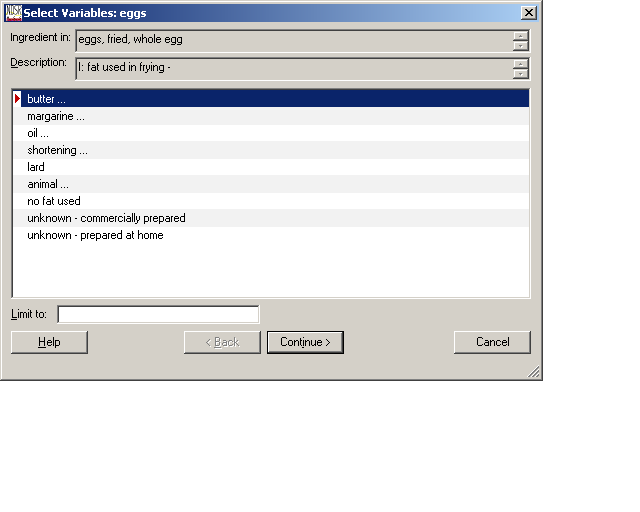
APPENDIX VII: MISSING FOOD WINDOW
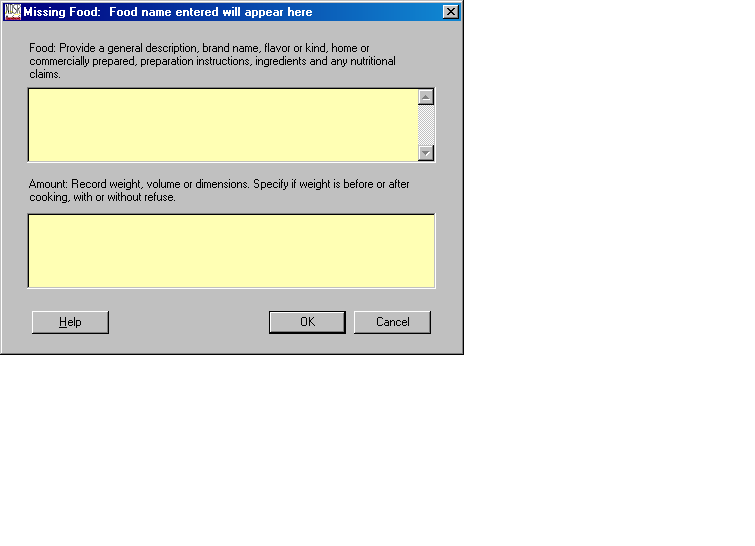
APPENDIX VIII: FOOD AMOUNT WINDOW
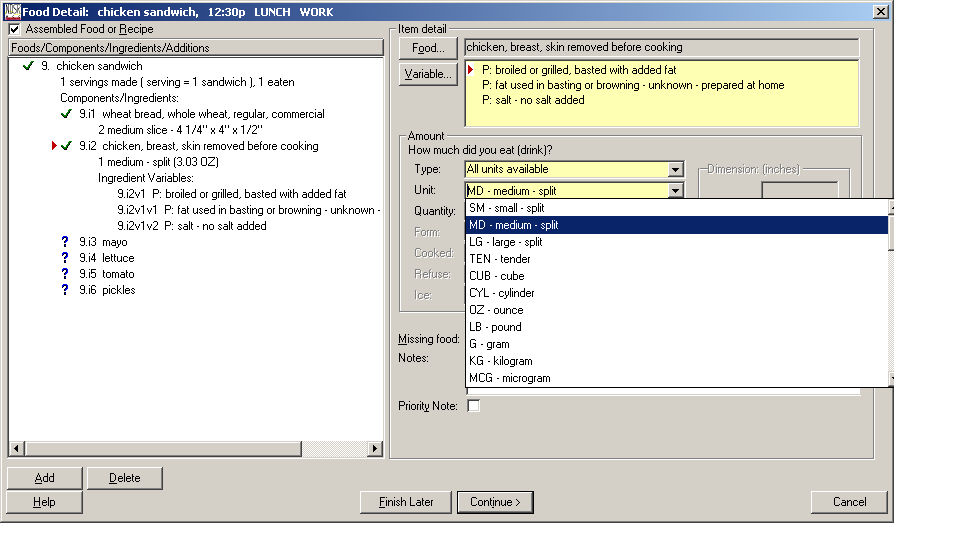
APPENDIX IX: FINAL REVIEW
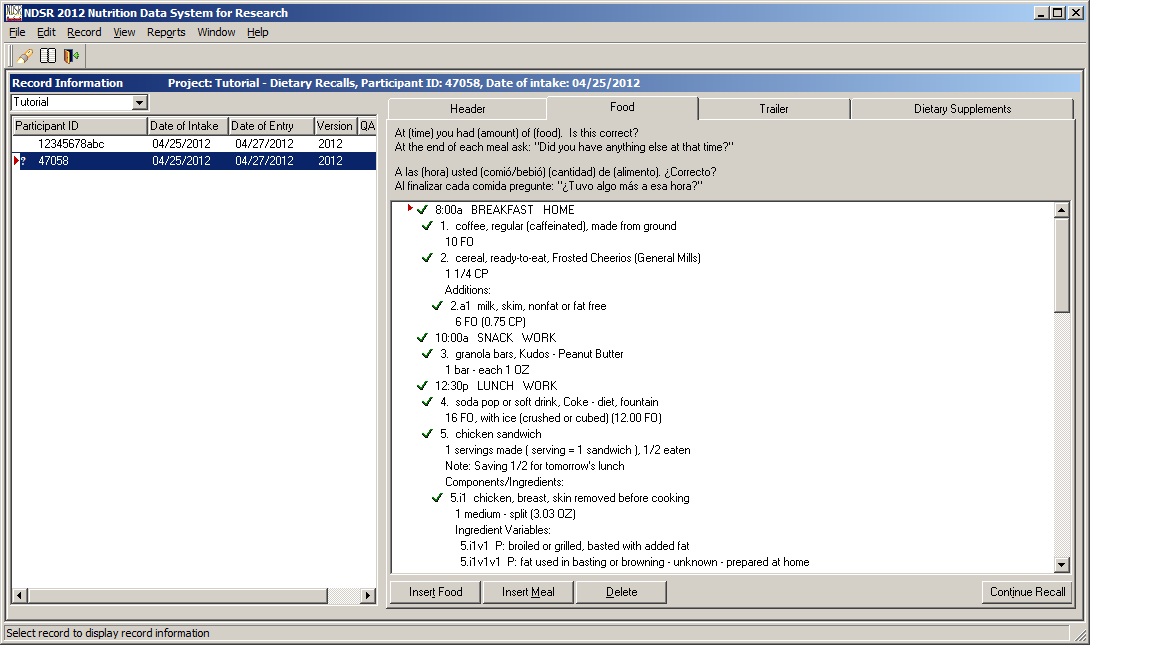
APPENDIX X: TRAILER TAB WINDOW
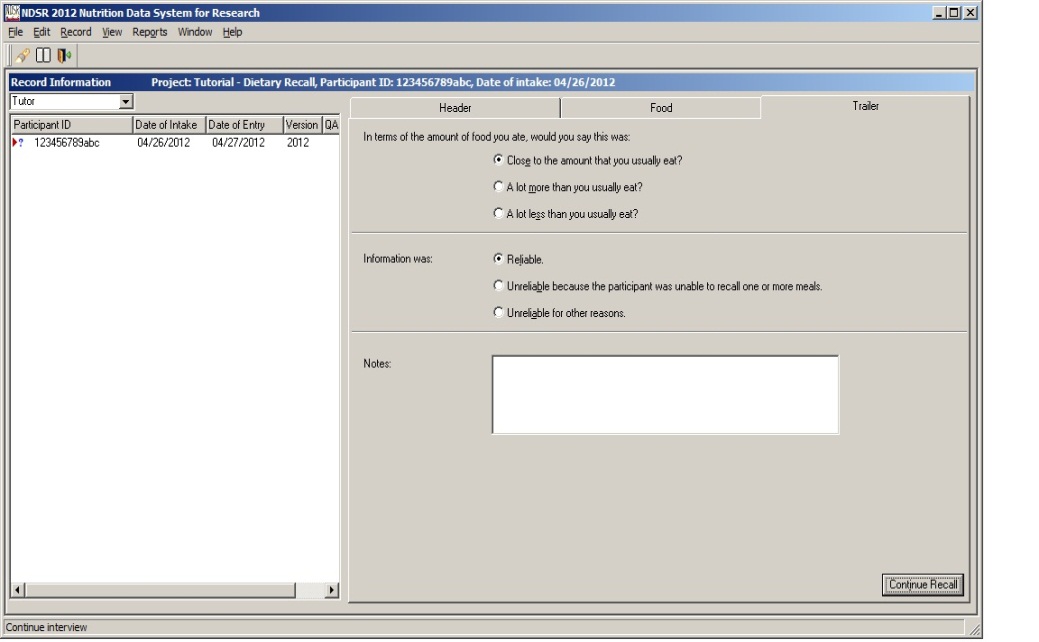
APPENDIX XI: DIETARY SUPPLEMENT AND NON-PRESCRIPTION ANTACID ASSESSMENT SCREENING QUESTION
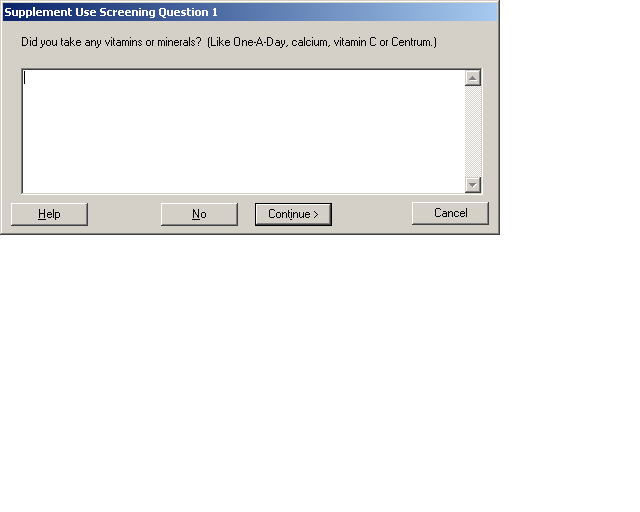
APPENDIX XII: PRODUCT SEARCH WINDOW
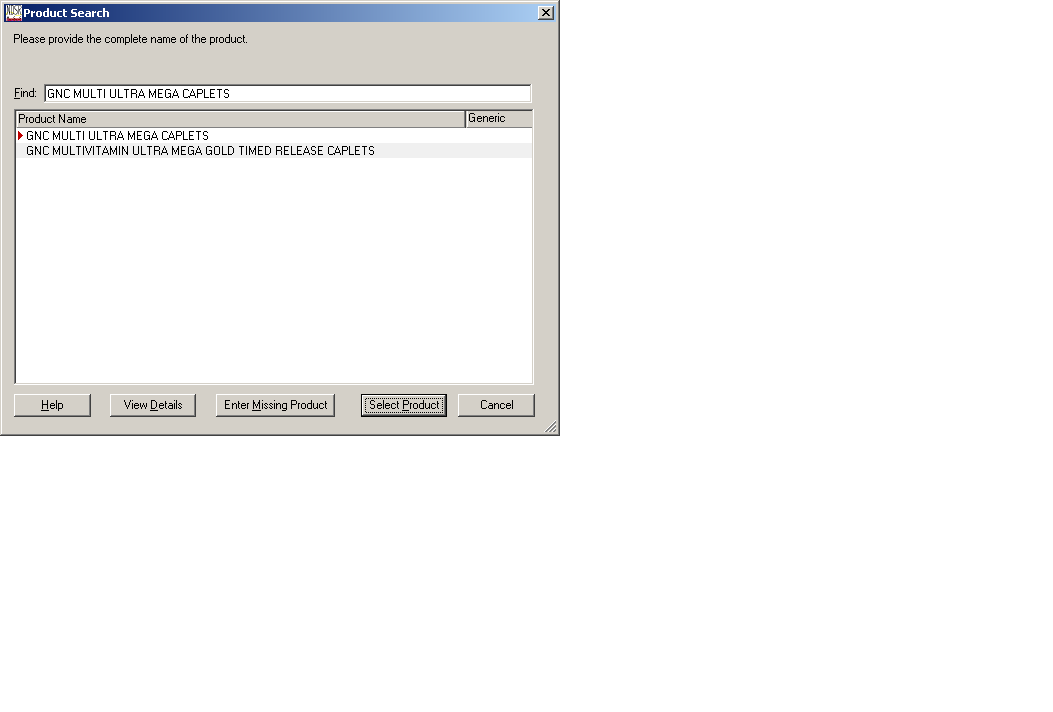
APPENDIX XIII: FINAL REVIEW WINDOW
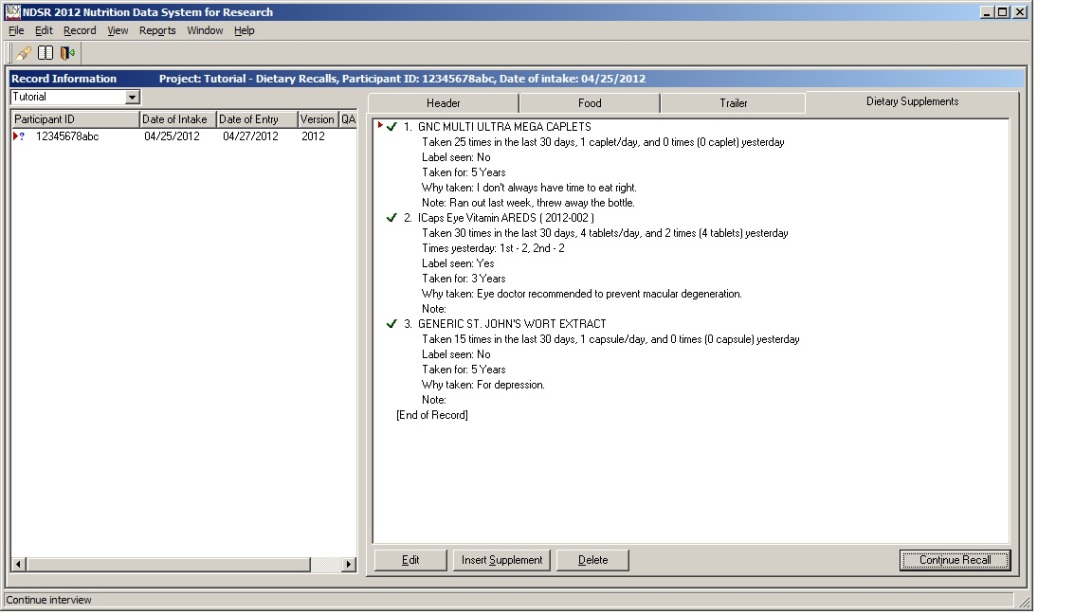
24-HOUR DIETARY RECALL INTERVIEW GUIDE
(Manual of Procedures)
Conducting the NDSR 24-hour Dietary Recall Interview
1.1 Introduction. Following a written script available for each interview the dietary interviewer introduces him/herself to the participant, verifies that information needed for the interview is available, and explains the recall process. See Appendix I for a copy of the introduction script used for each interview.
1.2 The NDSR Quick List. Within NDSR the Quick List is used to collect an outline of the previous day’s intake. It is designed to get participants to begin thinking about what and when they ate. Foods and beverages as reported by the participant are entered on the Quick List window along with the time eaten and meal name if provided by the participant at this time.
To collect the quick list the dietary interviewer asks the participant to make a list of all the foods and beverages he/she had yesterday. He/she says: “First, we’ll make a list in the computer of what you ate and drank. Then I will ask you some more questions and we’ll figure out how much you had to eat. Do you have any questions?” Pause, wait for and respond to questions, and proceed: “What was the first time you had something to eat or drink?” Enter the response then as needed say: “What did you have at that time?” The interviewer enters the information reported by the participant on the NDSR Quick List screen, not requiring the participant to give time, meal name, or meal location. A slash must be used for each eating occasion but no further detail is needed because NDSR will prompt later for the time and meal name. Above all, the interviewer should let the participant think and say whatever comes to mind about the previous day’s intake, avoiding interruptions that may be distracting to the participant.
See Appendix II for a screenshot of the quick list collection and review window.
1.3 Reviewing the Quick List.
During the review of the Quick List, it is important that the dietary interviewer try to visualize the entire 24-hour period in terms of what has been reported so far. This is a good opportunity to identify and ask about gaps of time when nothing has been reported and to check for frequently forgotten foods, such as beverages and snacks throughout the day. The dietary interviewer verifies all of the entries on the Quick List and probes for missed items by reading the list back to the participant and asking as appropriate: “I am going to read back what you have told me. Let me know if you want to add or change anything. Can you think of anything else you ate or drank yesterday that we haven’t put on the list? Do you remember if you got up during the night (after 10:00 pm or midnight) and had anything to eat or drink? Did you have any snacks after work or before bed?” Any errors should be corrected, and any additional foods the participant may report are added at this time.
See Appendix II for a screenshot of the quick list collection and review window.
1.4 Collecting Complete Meal, Food, and Amount Detail. Next the participant is asked to recall specific details about what they ate. Information about the time, name, and location of the meal are provided in the Meal Information window. The dietary interviewer completes descriptive details for foods and beverages obtained during the first pass. At this point, the participant is asked about additions to foods and beverages entered on the Quick List. The dietary interviewer asks probing questions based on the information displayed in the NDSR window and utilizes the NDSR food search feature to locate foods, and to obtain complete details for food descriptions, preparation methods, and variable ingredients. After specifying the detail for each food, an open-ended question “How much did you eat (drink)?” is asked to obtain the amount eaten.
1.4.1 Collecting Meal Information. The dietary interviewer begins by saying: “Next we’ll go over our list and I will ask you some questions about each food. You can use the amounts estimation tools at any time to let me know how much you had.” NDSR brings up the Meal Information window (see Appendix III). The dietary interviewer uses this opportunity to ask questions about meal time, meal name, and meal location if this information was not provided earlier during the Quick List.
1.4.2 Entering Meal Time. In general, the approach to collecting the 24-hour dietary recall is to find out when people eat and what they eat, versus asking what they ate for specific meals. The NDSR program does require a time for each eating occasion. Exact eating times are not important. A general time frame may be given with approximate times. When participants are not able to provide the time of meals and snacks, dietary interviewers may use the following times for a general framework, using additional times as needed for other meals or snacks reported:
Morning Meal: 7 am
Noon Meal: 12 pm
Afternoon Meal: 5 pm
Evening Snack: 8 pm
1.4.3 Entering the Meal Name. NDSR meal names include Breakfast, Lunch, Dinner/Supper, Snack, School Lunch, and Other. If the meal name is not stated by the participant, the dietary interviewer may ask the participant the meal name saying: “Was this your (insert most obvious meal name)?” Or “What would you call this meal? A meal name may be repeated several times in the context of a 24-hour intake. For example, the participant may report snacks several times throughout the day. If the name of the meal is obvious to the dietary interviewer, it is not necessary to ask the participant this question. For example, the first meal of the day may be labeled as breakfast and between-meal items may be labeled as snacks without probing.
1.4.4 Entering the Meal Location. NDSR meal locations include Home, Work, Friend’s Home, School, Day Care, Restaurant/Cafeteria/Fast Food, Deli/Take-out/Store, Community Meal Program, Party/Reception/Sporting Event, and Other. The meal location helps to determine which food variables to enter during the 24-hour dietary recall. For example, many foods in NDSR differentiate between home prepared and restaurant prepared foods. Collecting information on the source of the meal aids in the food description process
1.4.5 Asking About Additions. The dietary interviewer asks about additions to every food. An on-line prompt reminds him/her to say: “The first thing on your list is (NDSR inserts the name of each food).” Then, reading from the NDSR screen the dietary interviewer says: “Did you add anything to the (NDSR inserts the name of the food)?” The dietary interviewer continues asking the additions question for each food until a “no” response is received. See Appendix IV for a screenshot of the food additions window.
1.4.6 Collecting Complete Food Detail. The NDSR Food Search window (see screenshot in Appendix V) prompts the dietary interviewer for each available level of detail during this third pass. An on-line prompt reminds him/her to begin by saying: “What type of (insert name of food) was it?” The dietary interviewer continues defining the food, selecting food variables as required on each screen (see screenshot in Appendix VI). “Unknown” should be entered if the participant cannot describe the food in detail (e.g., if it was prepared at a restaurant).
Whenever a prompt requires asking if salt was added in cooking/preparation and the participant indicates it was, ask the participant if the food was prepared at home or elsewhere. In the notes field record ‘home,’ and ‘not-home,’ in the notes field based on the participant’s response. If the food was prepared at home ask the participant if he/she collected a duplicate salt sample for that food item. If they responded that they did, record ‘yes,’ in the notes field following the previously typed ‘home,’. If they responded that they did not ask them why they did not. If they respond they did not because the food was prepared a previous day, record ‘not previous day,’ in the notes field following the previously recorded ‘yes,’. If the response was that they forgot, didn’t have time, etc. record ‘missed,’ in the notes field following the previously recorded ‘yes,’. Finally, as the participant what proportion or fraction of the total dish/item prepared they consumed and record this in the notes field. For example, if they say they ate ¼ of the omelet record “1/4 ”.
1.4.7 Missing Foods. The dietary interviewer uses the Missing Food window (see Appendix VII) to describe food details and to specify amounts of a food not found in NDSR. The lead interviewer uses the New Food Request Form http://www.ncc.umn.edu/services/newfoodrequestform.php to submit a request to NCC. The lead interviewer includes all possible information about the missing food including the client number for the study. NCC will resolve the missing food using the information provided in this form. For all mixed dishes (home- or restaurant-prepared dishes) not found in NDSR, the dietary interviewer collects as much information as possible from the participant regarding name of the dish or food, country of origin, ingredients, amount eaten, method of preparation, and others and uses the Missing Food window to include those details.
1.4.8 Collecting Food Amount Information: An on-line prompt for the amount reminds the dietary interviewer to say: “How much did you eat (drink)?” (See Appendix VIII for screenshot of window). Some foods require additional quantity details, with required fields indicated in yellow. After entering the amount provided by the participant, the NDSR displays a conversion to a common unit. At this time, the dietary interviewer must be able to visualize the amount reported and confirm as needed any questionable amounts using the amount estimation tools or by making reference to other familiar items or recognizable standards. For example, 1/16 of a hamburger should have a note saying, “ate only one bite” or 8 cups of popcorn should have a note saying, “ate entire box.” The dietary interviewer should ask if the entire amount described was eaten: “Were you able to finish that? or the (insert name of food)?”
Note: Foods that do not have complete descriptive and/or complete amount information are indicated on the screen with a blue question mark to the left of the food. When the dietary interviewer has completely described a food, NDSR replaces the question mark with a green check mark to the left of each completed item. As the dietary interviewer conducts the 24-hour dietary recall, he/she provides positive reinforcement by stating thing like “you are doing a good job” as appropriate. The dietary interviewer should maintain a pleasant tone of voice and avoid responding to the participant in any negative ways. If it is necessary to ask the participant to repeat what he/she said, the dietary interviewer should ask him/her to do so in a gentle way and take ownership by saying: “Sometimes it’s hard for me to hear things. Could you please tell me that again?”
Guidelines for Amount Probing. After introducing the study amount estimation tools, the dietary interviewer emphasizes that these tools are not always needed for estimating amounts, he/she gives examples of amounts that can be expressed using food-specific unit such as a “large” apple, a “thin slice” of tomato. The dietary interviewer reminds the participant that he/she needs to know the amount actually eaten or drunk, not the total amount on the plate or in the glass, or the amount that was prepared for the entire family. When an amount is given by the participant, the dietary interviewer asks if he/she ate all or only a part of that amount.
Using NDSR Amount Prompts. Interviewers should not specify to the participant a particular method to use to estimate the amount of food or beverage. First, he/she asks a completely open-ended question such as, “how much juice did you drink?” This type of question encourages the participant to express the amount in his/her own words. If the participant appears to be having difficulty answering the question, the dietary interviewer may then suggest that he/she try to visualize the juice container and compare the amount with one of the amount estimation tools. If the participant continues having difficulty expressing the amount, the dietary interviewer might mention one or more of the options listed on the NDSR “Amounts Screen.” The choice of available food specific unit options varies depending on the specific food item.
Using NDSR Food Specific Units. For many foods, the food-specific units such as small, medium, and large are further described using dimensions. It is not necessary to probe further for dimensions once the participant has specified a size because the dimensions are meant to be guidelines and do not need to be exact. However, if participants ask what is meant by small, medium, or large, the dietary interviewer may share this information with them. He/she must ask if the participant ate the entire piece, if not, indicate the proportion of the small, medium, or large piece that was consumed.
Using the Marked Containers. When using measuring cups or the bowls or beverage containers with markings, dietary interviewers do not assume that the container was full. Always, ask “To what line?” before entering the amount information. If the participant reports eating more than one of an item that could be different sizes, the dietary interviewer needs to remember to ask if they were the same size.
Ice in Beverages. When a participant reports drinking a beverage that may have contained ice, the dietary interviewer needs to remember to ask if ice was included in the amount reported. When the beverage is with ice and this is an option in NDSR, the interviewer specifies the amount with ice and NDSR calculates the amount without ice. If an automatic calculation is not available in NDSR, the participant is asked to specify the amount of beverage without ice. If he/she is unable to do this, a note is entered for subsequent resolution at NCC using the NDSR Data Entry Rules.
Unconsumed Portions. The amount the participant actually consumed is what should be entered, not what he/she was served or cooked for the entire family. Double check to ensure that the amount reported is what was consumed. Asking “Were you able to finish that?” or “Did you eat all of it?” help to identify the unconsumed portions.
Unusual Portions. If something sounds unusual, the dietary interviewer should question it and not blindly accept the initial response. Redirecting questions and presenting appropriate alternatives from the amount estimation tools permit the participant to restate his/her initial response and allow the interviewer to verify, confirm, or correct an unusual portion. Confirmation of any unusual intake or portions should be documented using the NDSR Notes field by stating which amount estimation tool or picture in the Food Amounts Booklet was used. Specific information about confirming portions and documenting unusual portions is provided at the training workshop.
1.5 Reviewing the Dietary Intake Recall. After completing the last food or beverage reported, the dietary interviewer makes one last pass to probe for missed snacks, meals, foods or beverages, making sure no information was inadvertently overlooked (see Appendix IX for screenshot). He/she tries to get a mental picture of the day, looking especially for time gaps of more than four hours between eating. Notes should be made to indicate skipped meals or to explain large time gaps. Notes are also used to record the absence of foods, beverages or typical condiments served with food. During the review, the dietary interviewer reads back each food and amount, asking for confirmation from the participant. For example: “Now we’ll go over what I’ve put in the computer one last time. The first thing that I have is at (insert meal name and time) when you had (insert food name).”
When the dietary interviewer notices a large time gap he/she should ask: “Did you have anything to eat or drink after the last meal? Anything before your (insert time e.g., evening meal) and (before bed)?” Additional foods and meals are inserted at any time. If the participant hesitates and can’t remember eating anything for a long period of time, the dietary interviewer may say: “Can you think of what you were doing (after work, at dinner/supper time, etc.)? Sometimes if we think about what we were doing, where we were or whom we were with, it helps to remember what we ate.” The process continues until each meal and food has been reviewed and documented as needed in the NDSR notes.
1.6 Documentation Using NDSR Note Field. NDSR notes are used to clarify contradictory, questionable, or unusual food items or amounts, or to document cases where typical companion foods are not consumed. Notes serve as communication between the dietary interviewers and the lead interviewer/quality assurance scientist/study coordinator. NDSR forces a note when the amount reported exceeds what has been established in the database as more than the usual amount consumed at one time; such amounts should be confirmed with the participant. In this case, the amount is corrected or a meaningful note is added to explain how the large amount was determined. NDSR food notes should match the information in the data entry. For example, if the dietary interviewer enters 6 cups of ice cream, the note should describe how the participant determined that he/she ate 6 cups and the number 6 should be re-typed in the note field to ensure that a typographical error did not occur. Further probing might reveal that the ice cream was scooped into the bowl and consequently a reduction in the 6 cups to account for the air space between the scoops needs to be factored in. Redirecting the participant to the mounds or measuring cups might result in a more realistic amount for the ice cream. Important information to be included in notes might concern missing meals or beverages, reference to the specific amount estimation tools picture and size used to estimate unusually larger or small portions, missing condiments, and modifications of foods such as a McDonald’s cheeseburger, when only half of the bun was eaten. Notes allow the lead interviewer and the NCC to make appropriate changes to the recall to reflect what was actually eaten as well as confirming that the interviewer entered what the participant reported.
1.7 Completing the Trailer Tab. When the 24-hour dietary interview is completed, the system presents the Trailer tab (see Appendix X) and the dietary interviewer ends the recall saying: “Next (insert name of participant), in terms of the amount of food you ate, would you say this was close to the amount that you usually eat, a lot more than you usually eat, or a lot less than you usually eat?” This question refers to the overall amount of food for the day, not the type of food. The dietary interviewer records the participant response to the last question on the Trailer tab. If the participant reports a lot more, check “considerably more than usual” or a lot less than usual, check “considerably less than usual.” In either case, NDSR requires the dietary interviewer to provide a note that briefly states why the intake was not usual. For example, a celebration meal with a lot of foods or a participant not feeling well and not eating much can result in eating a lot more or a lot less than usual. If needed the dietary interviewer can say: “What makes you say it’s (a lot more or a lot less than usual)?”
The dietary interviewer will determine the reliability of the data. If the dietary recall is unreliable because the participant was unable to recall one or more meals or for some other reason, he/she clicks the appropriate NDSR button and adds the required NDSR Note. Dietary interviewers do not ask the participant this question, nor share their selection with him/her.
1.8 Assessing use of Dietary Supplement and Non-prescription Antacids
Seven screening questions will be asked to assess whether dietary supplements or non-prescription antacids were taken over the past 24-hours (see Appendix XI for screenshot of screening question).
If the participant reports using any dietary supplements or non-prescription antacids he/she will be asked to gather the bottles/containers for products used. For each product taken the participant will be asked for the full product name and the product will be located and selected in NDSR (see Appendix XII for product search screenshot). Also, for each product taken the participant will be asked how many times he/she took it and amount taken each time it was used. As a final step, all products reported will be reviewed to provide the participant with the opportunity to make corrections or additions (see Appendix XIII for product review screenshot).
| File Type | application/msword |
| File Title | Diet and Supplement MOP |
| Author | Stevens |
| Last Modified By | CDC User |
| File Modified | 2014-01-08 |
| File Created | 2013-02-01 |
© 2026 OMB.report | Privacy Policy